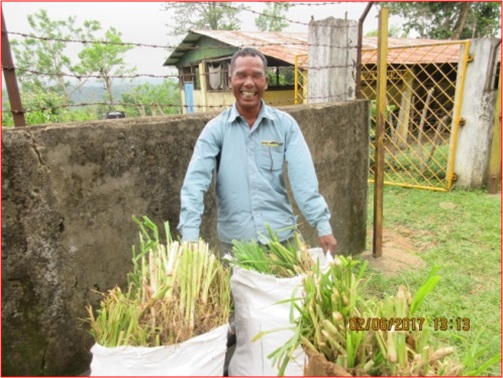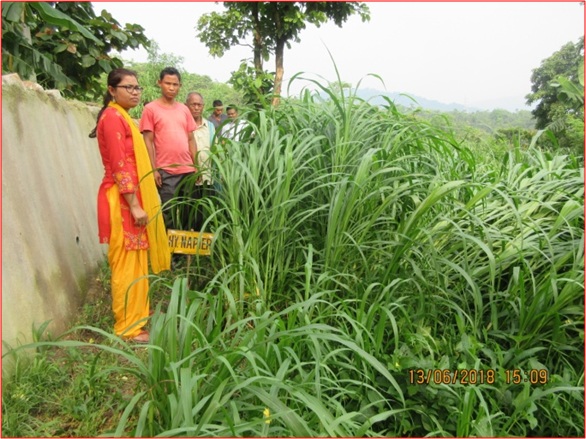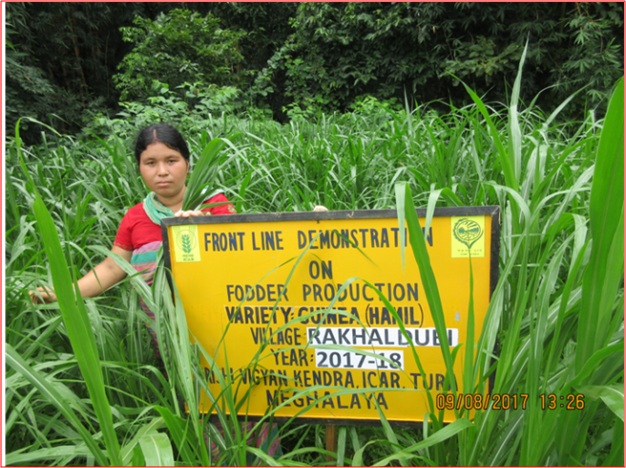Success Story on
Popularization of perennial fodder production among the dairy farmers in Garo Hills by KVK, West Garo Hills
Sagarika Borah1, Tanmay Samajdar2 and N. Arunkumar Singh1
1 ICAR-KVK, West Garo Hills, Meghalaya
2 ICAR-KVK, 24 North Parganas, WBIntroduction
The insignificant growth in dairy sector in Garo Hills is basically due to limited involvement of tribal population in milk production. But, Due to increase demand of milk as a wholesome food item for all, dairy sector is booming now also as an income generating activity for our poor farmers and rural youths. These farmers face a major problem in feeding of their cows as good quality feed resources are not available here. The feed resources used by the Garo farmers are not balanced in terms of protein and energy to meet the nutrient requirement of the animals leading to poor performance. Since feeding alone accounts for 60-70% of the total cost of milk production, availability of adequate nutritious fodder coming from cheaper sources assumes greater importance. The area under fodder is very minimal in Garo Hills districts. Farmers mainly depend on permanent pastures and grazing lands, waste lands, fallows etc for grazing of animals. But, these resources have been dwindling over time. The goal of the increased milk production can be achieved only through ensuring availability of good quality fodder in balanced ratio.
KVK intervention
Considering the gap between the demand and supply of good quality fodder in the district, first, Krishi Vigyan Kendra, West Garo Hills made aware the dairy farmers through different awareness programmes and introduced Hy. Napier (IGFRI 3), Guinea (Hamil), Congosignal and Stylosanthes grasses through its OFT programme. Training programme was organized for the beneficiaries by using the method of learning by doing. KVK has up scaled the demonstration on fodder production in the farmers’ field in every year in the last five years period (2013-18). KVK also provides fodder planting materials and seeds to the farmers whenever required by them.
Output and Outcome
At present more than 40 dairy farmers (having 4 and above cross bred cows) produce fodder grasses in West Garo Hills district. Hybrid Napier (IGFRI3) and guinea (Hamil) are gaining more popularity among the farmers due to their suitability and high yielding capacity. The average yield (per hectare area) of IGFRI3, Hamil, Congosignal and Stylosanthes in the district are 110t, 90t, 141.52q and 71t respectively. Farmers were able to reduce their cost of milk production by 40% due to availability of quality green fodder.
Impact
Perennial fodder production is gaining popularity not only in West Garo Hills district but also in other districts of Garo Hills. Dairy farmers from different parts of Garo Hills approached KVK and purchased fodder planting materials. State Veterinary Department, West Garo Hills and ATMA conducted training programmes on “Different perennial fodder Production” in collaboration with KVK and organized exposure visits for their farmers at fodder demonstration plots in KVK farm.











